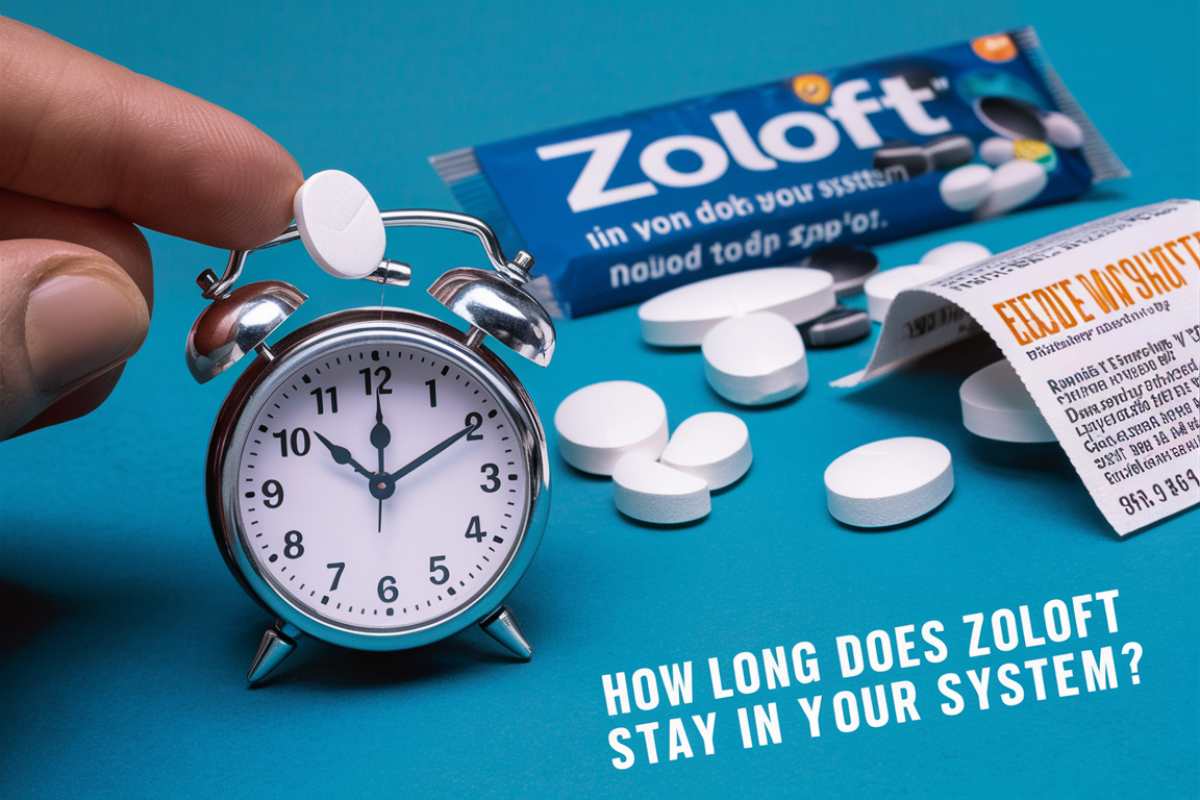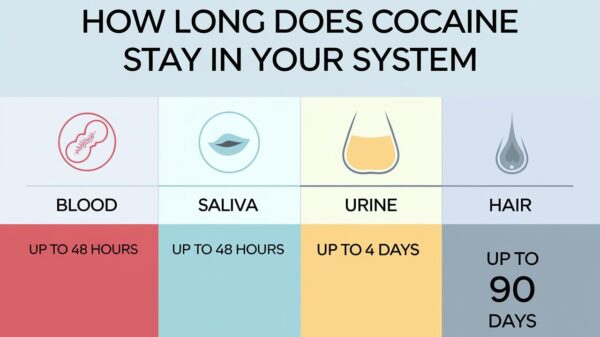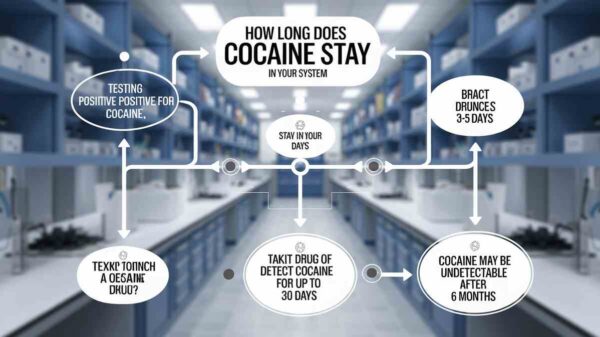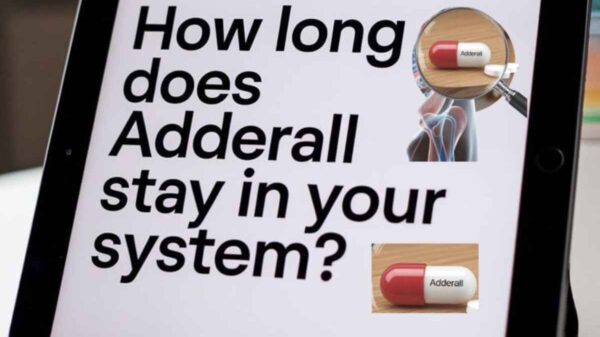Zoloft, known generically as sertraline, is a commonly prescribed medication for treating mental health conditions such as depression, anxiety, and obsessive-compulsive disorder. Understanding how long Zoloft stays in your system is crucial for managing its effects and potential interactions with other substances. This detailed guide provides insights into Zoloft’s duration in the body, how it is metabolized, and factors influencing its elimination, particularly after stopping the medication.
What Is Zoloft?
Zoloft is a selective serotonin reuptake inhibitor (SSRI) used to treat various mental health conditions by increasing serotonin levels in the brain. It is commonly prescribed for:
- Major depressive disorder
- Generalized anxiety disorder
- Panic disorder
- Social anxiety disorder
- Obsessive-compulsive disorder
Zoloft works by inhibiting serotonin reuptake, enhancing its availability in the brain. This process helps regulate mood and alleviate symptoms of depression and anxiety. The medication typically requires several weeks to achieve its full therapeutic effects.
What Is the Half-Life of Zoloft?
The half-life of a drug is the time needed for its concentration in the blood to decrease by half. For Zoloft, the average half-life is approximately 26 hours. This means that every 26 hours, the concentration of Zoloft in the bloodstream is reduced by half.
It generally takes about 5 to 6 half-lives for a drug to be eliminated from the body. Given Zoloft’s half-life, it usually remains in the system for about 5 to 7 days. However, traces of the medication may be detectable longer, depending on various factors.
How Long Does Zoloft Stay in Your System After Stopping?
Once Zoloft is stopped, it does not leave the body immediately. The time required for the drug to be cleared entirely depends on its half-life and how long it takes to reach a steady-state concentration. Zoloft generally remains in the system for several days after discontinuation. For most people, the medication is primarily eliminated within a week, but some residual traces might persist longer.
Zoloft reaches steady-state concentrations after about 4 to 5 half-lives of consistent dosing. After discontinuation, it takes additional time for the drug levels to drop below detectable levels. Therefore, even after stopping Zoloft, it remains in the system for a few days before being fully cleared.
How Long Does Zoloft Stay in Your Bloodstream?
Bloodstream Duration
Zoloft can be detected in the bloodstream for a period that aligns with its half-life. Given the average half-life of 26 hours, Zoloft generally remains detectable in the blood for about 1 to 2 days after the last dose. Blood tests can measure Zoloft levels during this time frame, reflecting how recently the medication was taken.
Factors Influencing Blood Levels
Several factors can influence how long Zoloft stays in the bloodstream, including:
- Dosage and Frequency: Higher doses & more frequent dosing can result in higher blood concentrations and a longer duration before the medication is fully cleared.
- Metabolism: Individual metabolic rates affect how quickly Zoloft is processed and eliminated from the blood. Faster metabolism can shorten the duration Zoloft is detectable.
- Liver Function: Since Zoloft is metabolized in the liver, impaired liver function can lead to prolonged presence in the bloodstream.
How Long Does Zoloft Stay in Your System for a Drug Test?
Drug Testing
Zoloft is not typically included in standard drug tests, which focus on substances like marijuana, cocaine, opioids, and amphetamines. However, if tested explicitly, Zoloft can be detected in various bodily fluids.
Detection Windows
- Urine Tests: Zoloft can generally be detected for 1-2 days after the last dose.
- Blood Tests: Zoloft may be detectable for a period similar to urine tests.
- Hair Tests: Although less commonly used, hair tests can detect Zoloft for a longer duration. They can identify Zoloft weeks to months after the last dose, but these tests are not standard for routine drug screenings.
How Long Does Sertraline Stay in Your System After Stopping?
Sertraline, the generic name for Zoloft, follows a similar elimination pattern. After stopping sertraline, it remains in the body for a comparable duration as Zoloft. Due to its half-life of approximately 26 hours, sertraline can be detected in the system for about 5 to 7 days after discontinuation. Factors such as dosage, duration of use, and individual metabolism can influence the exact duration.
The process of clearing sertraline from your system mirrors Zoloft’s. It involves a gradual reduction in blood concentration over time, with steady-state levels reaching within 4 to 5 half-lives of consistent dosing. Upon cessation, sertraline’s presence in the body decreases progressively, and most individuals will find that it is primarily eliminated within a week, although some traces may persist longer.
Factors Affecting Zoloft Elimination
Dosage and Duration of Use
The dosage and duration of Zoloft use can influence its elimination. Higher doses and prolonged use can increase accumulation in the body, potentially extending the time needed for clearance. Discontinuation after long-term or high-dose use may result in a more extended elimination period.
Metabolic Rate and Liver Function
Zoloft is metabolized in the liver by cytochrome P450 enzymes, particularly CYP2B6 and CYP2D6. Variations in enzyme activity can impact how quickly Zoloft is broken down. Individuals with faster metabolisms or healthy liver function may clear Zoloft more quickly, while those with liver impairments or slower metabolisms might experience a more extended elimination period.
Age and Body Weight
Age and body weight also affect Zoloft’s duration in the body. Older adults may have slower drug metabolism due to decreased liver function, leading to a prolonged presence of Zoloft. Additionally, body weight impacts the distribution and clearance of the medication, with higher body weight potentially resulting in a longer elimination time.
Interaction with Other Medications
Interactions with other medications can influence Zoloft metabolism. Drugs that suppress or induce cytochrome P450 enzymes can alter Zoloft levels. Enzyme inhibitors can slow Zoloft’s metabolism, resulting in higher levels and a longer duration in the system. Conversely, enzyme inducers can speed up Zoloft metabolism, potentially reducing its presence in the body.
Symptoms and Side Effects During Elimination
Withdrawal Symptoms
Discontinuing Zoloft, especially abruptly, can lead to withdrawal symptoms such as:
- Dizziness
- Nausea
- Irritability
- Flu-like symptoms
To mitigate withdrawal effects, it is crucial to consult your healthcare provider before stopping Zoloft. They can help create a tapering plan to reduce the medication and manage withdrawal symptoms effectively gradually.
Managing Side Effects
Managing withdrawal symptoms involves open communication with your healthcare provider. They can offer guidance on tapering off Zoloft gradually to minimize discomfort. If you experience severe or tenacious symptoms, seek medical advice promptly.
Can You Go Back to Normal After Zoloft?
After discontinuing Zoloft, many individuals return to their baseline mental health status, although this can vary. While Zoloft helps manage symptoms of mental health conditions, once the medication is stopped, symptoms might reappear or change. A plan with your healthcare provider must be in place to manage any returning symptoms or new challenges.
Regular follow-ups with your medical practitioner can help you navigate the transition off Zoloft. They can offer support, alternative treatments, and strategies to address lingering or recurring symptoms. Going back to normal may involve adjusting treatment plans and incorporating supportive therapies to maintain mental health stability.
Conclusion
Understanding how long Zoloft and its generic form, sertraline, stay in your system is crucial for managing its effects, especially when discontinuing the medication or considering interactions with other drugs. With an average half-life of 26 hours, Zoloft typically remains in the system for about 5 to 7 days and in the bloodstream for about 1 to 2 days. Various factors, including dosage, liver function, age, body weight, and medication interactions, can affect the duration of Zoloft in your system.
If you are considering stopping Zoloft or have concerns about its presence in your body or for drug testing purposes, consult with your healthcare provider to ensure a safe & effective process. Proper management and communication with your healthcare team can help minimize withdrawal symptoms and align your treatment plan with your health needs.
Frequently Asked Questions (FAQ)
Zoloft typically takes about 5 to 7 days to mostly clear from your system after stopping, thanks to its average half-life of 26 hours. Full elimination may vary based on factors like dosage, metabolism, and liver function. Individual experiences can differ, so consult your healthcare provider for personalized advice.
Yes, many people return to their baseline state after discontinuing Zoloft, though the transition can vary. Some may experience withdrawal symptoms or a temporary return of symptoms. Consulting a healthcare provider for a tapering plan can help manage the process effectively.
A 25 mg dose of sertraline typically stays in your system for about 5 to 7 days, given its half-life of approximately 26 hours. The drug’s elimination can be influenced by factors such as metabolism and liver function. Individual experiences may vary, so consult your healthcare provider for specific concerns.
Zoloft typically stays in the body for about 5 to 7 days after the last dose, due to its half-life of approximately 26 hours.

















